Towards Sustainable Waste Management: Predictive Modelling of Illegal Dumping Risk Zones Using Circular Data Loops and Remote Sensing
Abstract
1. Introduction
2. Related Work
3. Materials and Methods
3.1. Circular Data Loop Concept
3.2. Definition of the Basic Data Structure of the LNOP and Discussion of Existing Thematically Linked Data
3.2.1. Definition of the Basic Data Structure of the LNOP Register
- Unique identifier (ID)
- Identification Status (SIF_STAT_PREP)
- -
- Identified in the field by stakeholders
- -
- Identified by image analytics (e.g., orthophotos and aerial images)
- -
- Identified from other sources of information (e.g., word of mouth and Ecologists Without Borders (EBM, etc.))
- User group (SIF_UPO_SKU)
- -
- Citizens, third parties
- -
- Representatives of local authorities (e.g., inter-municipal inspectors and municipalities)
- -
- Public service providers
- -
- System administrators
- Status or validation (SIF_STAT_POT)
- -
- Not validated—values not validated
- -
- Validated—values validated by administrator
- Priority of treatment (SIF_PRIORITY)
- -
- First priority—immediate action required
- -
- Second priority
- -
- Third priority
- -
- Jurisdiction (SIF_PRIS)
- -
- Intermunicipal inspection
- -
- State inspection
- Date of entry (DAT_ENTRY)
- Date of treatment (DAT_OBR)
- Note (NOTE_STATUS)
- Unique identifier (ID)
- X and Y coordinate (D96/TM)
- Coordinate λ (Lon) and φ (Lat)
- Municipality (SIF_OB)
- Cadastral municipality (SIF_KO)
- Narrow part of the municipality (SIF_ODO)
- Note (NOTE_LOK)
- Unique identifier (ID)
- Area (POV)
- Comparative volume (SIF_PROS)
- Volume (PROS)
- Waste type (SIF_ODP_1…10)
- Waste fraction (DELEZ_ODP_1…10)
- Note (NOTE_ODP)
- Unique identifier (ID)
- Waste Owner (LAST_ODP)
- Generator (POVZ_ODP)
- Landowner (LAST_PARC)
- Remediation obligation (SIF_OBV_SAN)
- -
- Waste owner
- -
- Generator
- -
- Landowner
- -
- Public service operator
- -
- Clean-up action
- Remediation status (SIF_STAT_SAN)
- -
- Existing
- -
- Remediated
- Note (OPO)
3.2.2. Review, Analysis and Adaptation of Existing Thematically Linked Data
3.2.3. On-Site Verification of Previously Known Locations and Identification of New Illegal Waste Disposal Sites
3.3. Modeling of LNOP Potential Areas
3.3.1. Assessment of Influential Factors—Available Datasets
Accessibility—National and Municipal Roads
OpenStreetMap (OSM)
Settlement Patterns
Terrain-Relief, LIDAR
Terrain-Land Cover/Vegetation
Actual Land Use
Functionally Degraded Areas
Areas of Past and Current Waste Collection Centers
Other Public Economic Infrastructure
Electric Power Network
Public Lighting
Railway Infrastructure
3.3.2. Modelling Potential LNOP Risk Areas—Risk Assessment Map
3.4. Remote Sensing for LNOP Recognition
3.5. Software-Based Support
4. Results
4.1. First Data Loop—Iteration
4.2. Second Data Loop—Iteration
4.3. Third Data Loop—Iteration
4.4. Loop Comparison
5. Discussion
- Settlement patterns and house number density,
- Public lighting infrastructure and power corridors,
- Functionally degraded areas and land cover classes,
- LIDAR-based terrain features and vegetation masks, and
- Road and rail infrastructure.
- Targeted monitoring: Municipalities and inspection bodies can use risk maps to optimize UAV inspections and enforcement operations.
- Digital civic engagement: The EkoVaruh application enhances public participation, aligning with principles of participatory environmental governance (e.g., LIFE Restart).
- Scalability and transferability: The model’s reliance on open-source tools and publicly available geospatial datasets makes it applicable across other Slovenian regions and transnational contexts (e.g., Northern Italy, Croatia, Austria and elsewhere).
6. Conclusions
- Automatic recognition of waste types and quantities, including total volume and the share of each waste type, based on uploaded photographs;
- Intelligent prioritization based on environmental risk;
- Geographic tasking of field inspection teams;
- Integration with national-level GIS infrastructure.
Supplementary Materials
Author Contributions
Funding
Institutional Review Board Statement
Informed Consent Statement
Data Availability Statement
Acknowledgments
Conflicts of Interest
Abbreviations
| CNN | Convolutional Neural Network |
| CRP | Central Population Register |
| EBM | Ecologist without Borders |
| FRO | Functionally Degraded Areas |
| GIS | Geographical Information System |
| GURS | Geodetic Administration of the Republic of Slovenia |
| LIDAR | Laser Imaging, Detection and Ranging |
| LNOP | Illegal Waste Disposal Sites |
| MOM | Municipality of Maribor |
| OSM | Open Street Map |
| RSOD | Real-Time Small Object Detection |
| SLCA | Social Life Cycle Assessment |
| SSD | Single Shot Multibox Detector |
| UAV | Unmanned Aerial Vehicle |
| ZKGJI | Consolidated Cadaster of Public Economic Infrastructure |
| ZVO-2 | Environmental Protection Act |
| YOLO | You Only Look Once |
References
- European Parliament. Directive 2008/98/EC of The European Parliament and of the Council of 19 November 2008 on Waste and Repealing Certain Directives (Text with EEA Relevance). Available online: https://eur-lex.europa.eu/legal-content/EN/TXT/HTML/?uri=CELEX:32008L0098 (accessed on 7 July 2025).
- Vlada Republike Slovenije, Ministrstvo za Okolje in Prostor. Program Ravnanja z Odpadki in Program Preprečevanja Odpadkov Republike Slovenije. 2022. Available online: https://www.gov.si/assets/ministrstva/MOP/Operativni-programi/op_odpadki_2022.pdf (accessed on 17 May 2025).
- Chamizo-González, J.; Cano-Montero, E.I.; Muñoz-Colomina, C.I. Does Funding of Waste Services Follow the Polluter Pays Principle? The Case of Spain. J. Clean. Prod. 2018, 183, 1054–1063. [Google Scholar] [CrossRef]
- Panzone, L.; Ulph, A.; Areal, F.; Grippo, V. A Ridge Regression Approach to Estimate the Relationship between Landfill Taxation and Waste Collection and Disposal in England. Waste Manag. 2021, 129, 95–110. [Google Scholar] [CrossRef] [PubMed]
- Sirimewan, D.; Bazli, M.; Raman, S.; Mohandes, S.R.; Kineber, A.F.; Arashpour, M. Deep Learning-Based Models for Environmental Management: Recognizing Construction, Renovation, and Demolition Waste in-the-Wild. J. Environ. Manag. 2024, 351, 119908. [Google Scholar] [CrossRef]
- Alsheyab, M.A.T. Recycling of Construction and Demolition Waste and Its Impact on Climate Change and Sustainable Development. Int. J. Environ. Sci. Technol. 2022, 19, 2129–2138. [Google Scholar] [CrossRef]
- Etim, E. Leveraging Public Awareness and Behavioural Change for Entrepreneurial Waste Management. Heliyon 2024, 10, e40063. [Google Scholar] [CrossRef]
- van Ewijk, S.; Stegemann, J.A. Recognising Waste Use Potential to Achieve a Circular Economy. Waste Manag. 2020, 105, 1–7. [Google Scholar] [CrossRef]
- Kapoor, N.; Sulke, P.; Badiye, A. E-Waste Forensics: An Overview. Forensic Sci. Int. Anim. Environ. 2021, 1, 100034. [Google Scholar] [CrossRef]
- Mishra, P.; Kaviarasan, T.; Sambandam, M.; Dhineka, K.; Murthy, M.V.R.; Iyengar, G.; Singh, J.; Ravichandran, M. Assessment of National Beach Litter Composition, Sources, and Management along the Indian Coast-a Citizen Science Approach. Mar. Pollut. Bull. 2023, 186, 114405. [Google Scholar] [CrossRef]
- Mondal, S.; Mandal, B. Assessment of Urban Solid Waste Management in a Class II Indian City Using Geospatial and Statistical Approaches: A Case Study of Rampurhat Municipality. Waste Manag. Bull. 2024, 1, 74–92. [Google Scholar] [CrossRef]
- Vaverková, M.D.; Maxianová, A.; Winkler, J.; Adamcová, D.; Podlasek, A. Environmental Consequences and the Role of Illegal Waste Dumps and Their Impact on Land Degradation. Land Use Policy 2019, 89, 104234. [Google Scholar] [CrossRef]
- Kolenda, K.; Kuśmierek, N.; Kujawa, K.; Smolis, A.; Wiśniewski, K.; Salata, S.; Maltz, T.K.; Stachowiak, M.; Kadej, M. Bottled & Canned–Anthropogenic Debris as an Understudied Ecological Trap for Small Animals. Sci. Total Environ. 2022, 837, 155616. [Google Scholar] [CrossRef]
- Northern Ireland Environment Agency. NIEA Reveals Illegal Fly-Tipping Costs. Available online: https://www.daera-ni.gov.uk/news/niea-reveals-illegal-fly-tipping-costs (accessed on 21 March 2025).
- BigRentz. Illegal Dumping Facts and the Consequences of Carelessness. Available online: https://www.bigrentz.com/blog/illegal-dumping-facts?srsltid=AfmBOoopMnxvLK3aDtmJOZkAgVw6oO4IMBDWDwVnGY8kI4Bgq8ZB4fnz (accessed on 21 March 2025).
- Statista. Average Cost to Landfill Municipal Solid Waste in the United States in 2022 and 2023, by Region (in U.S. Dollars per Ton). Available online: https://www.statista.com/statistics/692063/cost-to-landfill-municipal-solid-waste-by-us-region/ (accessed on 13 June 2025).
- Locke, S.; Toma, M.; Beck, J. The Impact of Gunfire on Residential Property Values. Appl. Econ. 2024, 7, 297–314. [Google Scholar] [CrossRef]
- Ready, R.C. Do Land Fills Always Depress Nearby Property Values? J. Real Estate Res. 2010, 32, 321–339. [Google Scholar] [CrossRef]
- Lu, W. Big Data Analytics to Identify Illegal Construction Waste Dumping: A Hong Kong Study. Resour. Conserv. Recycl. 2019, 141, 264–272. [Google Scholar] [CrossRef]
- Persechino, G.; Schiano, P.; Lega, M.; Napoli, R.M.A.; Ferrara, C.; Kosmatka, J. Aerospace-Based Support Systems and Interoperability: The Solution to Fight Illegal Dumping. WIT Trans. Ecol. Environ. 2010, 140, 203–214. [Google Scholar] [CrossRef]
- Glanville, K.; Chang, H.C. Mapping Illegal Domestic Waste Disposal Potential to Support Waste Management Efforts in Queensland, Australia. Int. J. Geogr. Inf. Sci. 2015, 29, 1042–1058. [Google Scholar] [CrossRef]
- Santos, A.C.; Mendes, P.; Ribau Teixeira, M. Social Life Cycle Analysis as a Tool for Sustainable Management of Illegal Waste Dumping in Municipal Services. J. Clean. Prod. 2019, 210, 1141–1149. [Google Scholar] [CrossRef]
- Sliusar, N.; Filkin, T.; Huber-Humer, M.; Ritzkowski, M. Drone Technology in Municipal Solid Waste Management and Landfilling: A Comprehensive Review. Waste Manag. 2022, 139, 1–16. [Google Scholar] [CrossRef]
- Li, Z.; Wang, Y.; Zhang, N.; Zhang, Y.; Zhao, Z.; Xu, D.; Ben, G.; Gao, Y. Deep Learning-Based Object Detection Techniques for Remote Sensing Images: A Survey. Remote Sens. 2022, 14, 2385. [Google Scholar] [CrossRef]
- Silvestri, S.; Omri, M. A Method for the Remote Sensing Identification of Uncontrolled Landfills: Formulation and Validation. Int. J. Remote Sens. 2008, 29, 975–989. [Google Scholar] [CrossRef]
- Torres, R.N.; Fraternali, P. Learning to Identify Illegal Landfills through Scene Classification in Aerial Images. Remote Sens. 2021, 13, 4520. [Google Scholar] [CrossRef]
- Paunovic, S.; Krstic, F. GIS Application in the Spatial Analysis of Illegal Landfills in Big Cities: A Case Study of Belgrade. Glas. Srp. Geogr. Drus. 2014, 94, 41–54. [Google Scholar] [CrossRef]
- Griggilo, D. Automatic Building Detection from High Resolution Imagery for Maintenance of Topographic Data. Ph.D. Thesis, University of Ljubljana, Ljubljana, Slovenia, 2010. [Google Scholar]
- Bekker, J.; Davis, J. Learning from Positive and Unlabeled Data: A Survey. Mach. Learn. 2020, 109, 719–760. [Google Scholar] [CrossRef]
- Liu, F.T.; Ting, K.M.; Zhou, Z.H. Isolation Forest. In Proceedings of the 2008 Eighth IEEE International Conference on Data Mining, Pisa, Italy, 15–19 December 2008; pp. 413–422. [Google Scholar]
- Noumir, Z.; Honeine, P.; Richard, C. On Simple One-Class Classification Methods. In Proceedings of the 2012 IEEE International Symposium on Information Theory Proceedings, Cambridge, MA, USA, 1–6 July 2012; pp. 2022–2026. [Google Scholar]
- Elkan, C.; Noto, K. Learning Classifiers from Only Positive and Unlabeled Data. In Proceedings of the 14th ACM SIGKDD International Conference on Knowledge Discovery and Data Mining, Las Vegas, NV, USA, 24–27 August 2008; ACM: New York, NY, USA, 2008; pp. 213–220. [Google Scholar]
- Ekologi brez meja. Register Divjih Odlagališč. Available online: https://ebm.si/glavna/web/ (accessed on 15 April 2025).
- Matos, J. Dejavniki Prostorske Razporeditve Divjih Odlagališč Odpadkov. Doctoral Dissertation, University of Ljubljana, Ljubljana, Slovenia, 2015. [Google Scholar]
- Wikipedia. Mestna občina Maribor. Available online: https://sl.wikipedia.org/wiki/Mestna_ob%C4%8Dina_Maribor (accessed on 7 September 2025).
- Wikipedia. Slovenija. Available online: https://sl.wikipedia.org/wiki/Slovenija (accessed on 7 September 2025).
- Ministrstvo za Okolje in Prostor. Uredba o Odpadkih, Uradni List RS, Št. 77/22 in 113/23. Available online: https://www.uradni-list.si/_pdf/2022/Ur/u2022077.pdf (accessed on 9 April 2025).
- Mestna Občina Maribor Čistilna Akcija 2025–Moji Odpadki, Moja Skrb. Available online: https://maribor.si/mestni-servis/cisto-okolje/cistilna-akcija-2025-moji-odpadki-moja-skrb/ (accessed on 10 April 2025).
- Ministrtvo za Okolje, Prostor in Energijo. Pravilnik o Vsebini in Načinu Vodenja Zbirke Podatkov o Dejanski Rabi. Available online: https://eprostor.gov.si/ (accessed on 25 June 2025).
- Geodetska Uprava Republike Slovenije. E-Geodetski Podatki. Available online: https://www.e-prostor.gov.si/ (accessed on 15 May 2025).
- Geodetska Uprava Republike Slovenije. Zbirni Kataster Gospodarske Javne Infrastrukture. Available online: https://eprostor.gov.si/imps/srv/slv/catalog.search#/metadata/923dfad8-6172-4ffa-be2a-4436e26a8d78 (accessed on 18 June 2025).
- Open Street Map. Available online: https://www.openstreetmap.org/ (accessed on 18 June 2025).
- Ministrstvo za Naravne Vire in Prostor—Geodetska Uprava Republike Slovenije. Register Naslovov. Available online: https://www.e-prostor.gov.si/podrocja/prostorske-enote-in-naslovi/register-naslovov/ (accessed on 21 June 2025).
- Statistični Urad Republike Slovenije, SURS. Available online: http://www.stat.si/statweb (accessed on 22 May 2025).
- Slovenski INSPIRE Metapodatkovni Sistem. Centralni Register Prebivalstva. Available online: https://eprostor.gov.si/imps/srv/slv/catalog.search#/metadata/62d37025-7056-4b20-96c9-db267ec929e6 (accessed on 21 June 2025).
- Agencija Republike Slovenije za Javnopravne Evidence in Storitve—AJPES. Poslovni Register Slovenije. Available online: https://www.ajpes.si/registri/poslovni_register/splosno (accessed on 21 June 2025).
- Slovenski INSPIRE Metapodatkovni Sistem. Ciklično Lasersko Skeniranje. Available online: https://eprostor.gov.si/imps/srv/slv/catalog.search#/metadata/951eaa88-0f6b-4d29-8d02-eaf56534453e (accessed on 21 June 2025).
- Ministrstvo za Naravne Vire in Prostor—Geodetska Uprava Republike Slovenije. Dejanska Raba Zemljišč. Available online: https://www.e-prostor.gov.si/podrocja/parcele-in-stavbe/kataster-nepremicnin/?acitem=1714-2253 (accessed on 21 June 2025).
- Oddelek za Geografijo Filozofske Fakultete Univerze v Ljubljani. Funkcionalno Razvrednotena Območja. Available online: http://crp.gis.si/ (accessed on 21 June 2025).
- Kamnik, R.; Jelenko, S.D.; Perc, M.N. Applicability of Semi-pro Unmanned Aircraft System for Rapid Archaeological Documentation in Forested Areas. Archaeol. Prospect. 2022, 29, 229–241. [Google Scholar] [CrossRef]
- Government of the Republic of Slovenia. Uradni List Republike Slovenije UL Št. 195/20; Government of the Republic of Slovenia: Ljubljana, Slovenia, 2020; Volume 195. [Google Scholar]
- TrashOut. Available online: https://www.trashout.ngo/ (accessed on 23 June 2025).
- Cicala, L.; Gargiulo, F.; Parrilli, S.; Amitrano, D.; Pigliasco, G. Progressive Monitoring of Micro-Dumps Using Remote Sensing: An Applicative Framework for Illegal Waste Management. Sustainability 2024, 16, 5695. [Google Scholar] [CrossRef]
- Youme, O.; Bayet, T.; Dembele, J.M.; Cambier, C. Deep Learning and Remote Sensing: Detection of Dumping Waste Using UAV. Procedia Comput. Sci. 2021, 185, 361–369. [Google Scholar] [CrossRef]
- Quesada-Ruiz, L.C.; Rodriguez-Galiano, V.; Jordá-Borrell, R. Characterization and Mapping of Illegal Landfill Potential Occurrence in the Canary Islands. Waste Manag. 2019, 85, 506–518. [Google Scholar] [CrossRef]
- Tasaki, T.; Kawahata, T.; Osako, M.; Matsui, Y.; Takagishi, S.; Morita, A.; Akishima, S. A GIS-Based Zoning of Illegal Dumping Potential for Efficient Surveillance. Waste Manag. 2007, 27, 256–267. [Google Scholar] [CrossRef]
- Seror, N.; Portnov, B.A. Identifying Areas under Potential Risk of Illegal Construction and Demolition Waste Dumping Using GIS Tools. Waste Manag. 2018, 75, 22–29. [Google Scholar] [CrossRef]
- Jordá-Borrell, R.; Ruiz-Rodríguez, F.; Lucendo-Monedero, Á.L. Factor Analysis and Geographic Information System for Determining Probability Areas of Presence of Illegal Landfills. Ecol. Indic. 2014, 37, 151–160. [Google Scholar] [CrossRef]
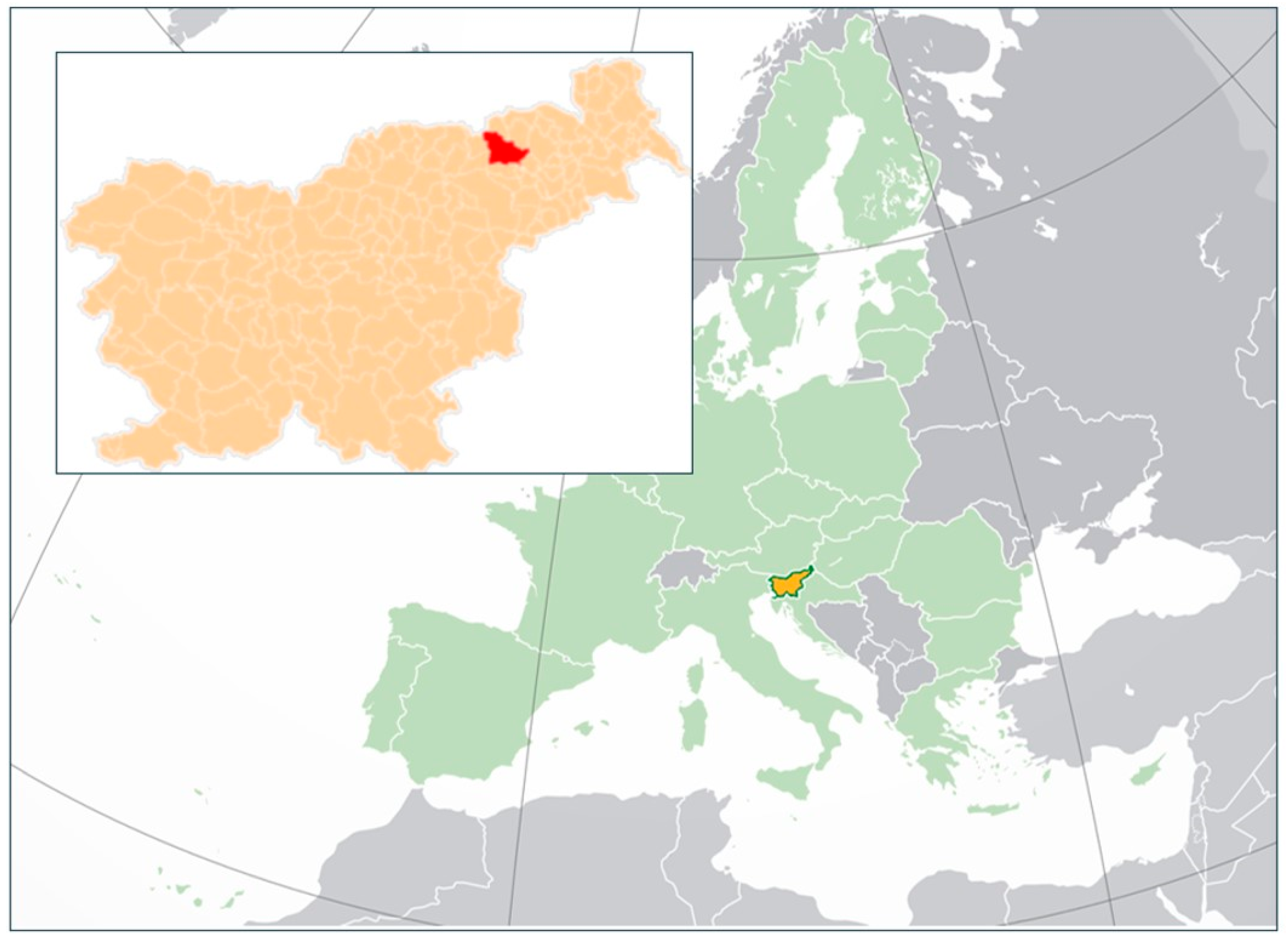
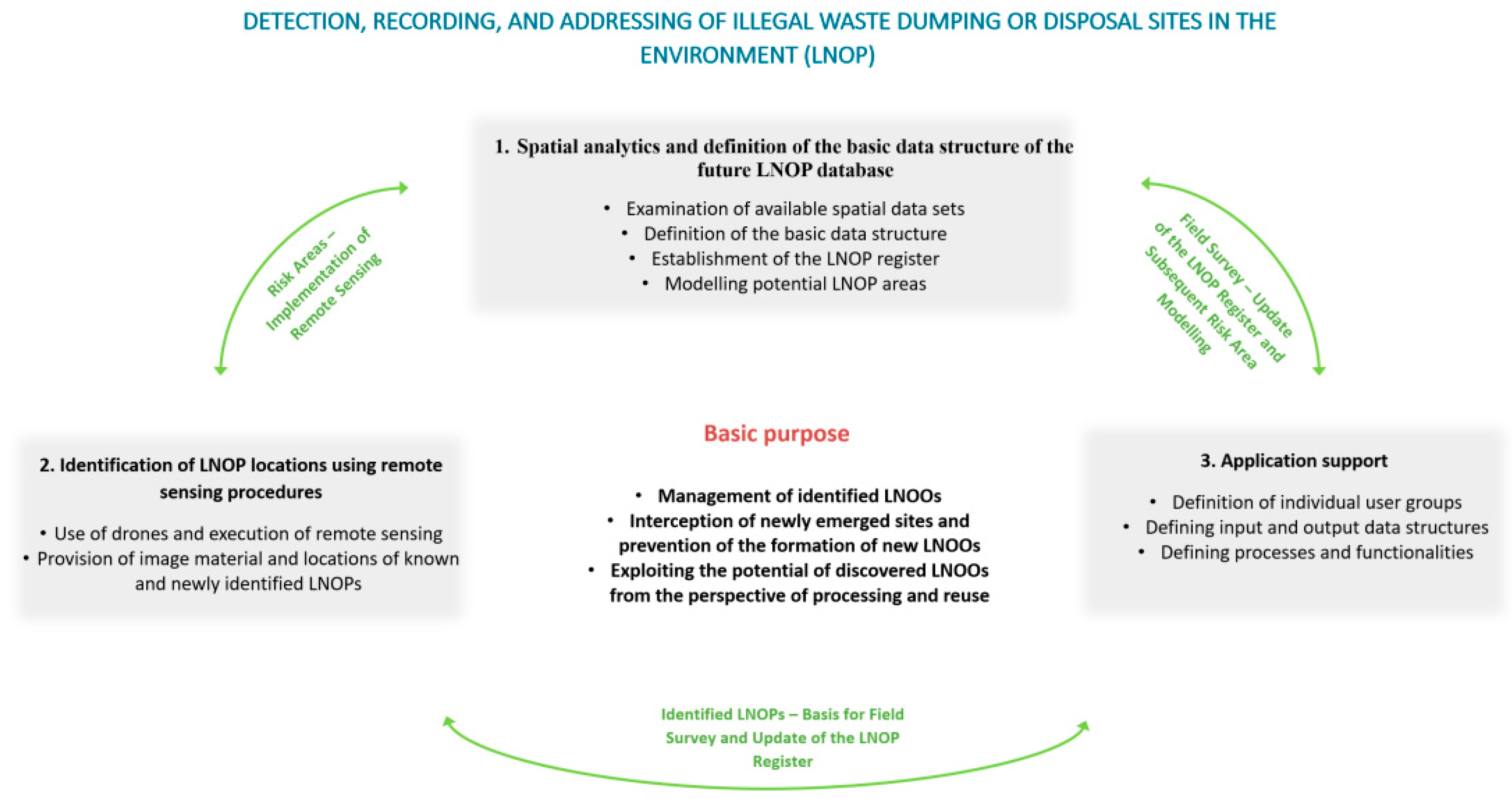
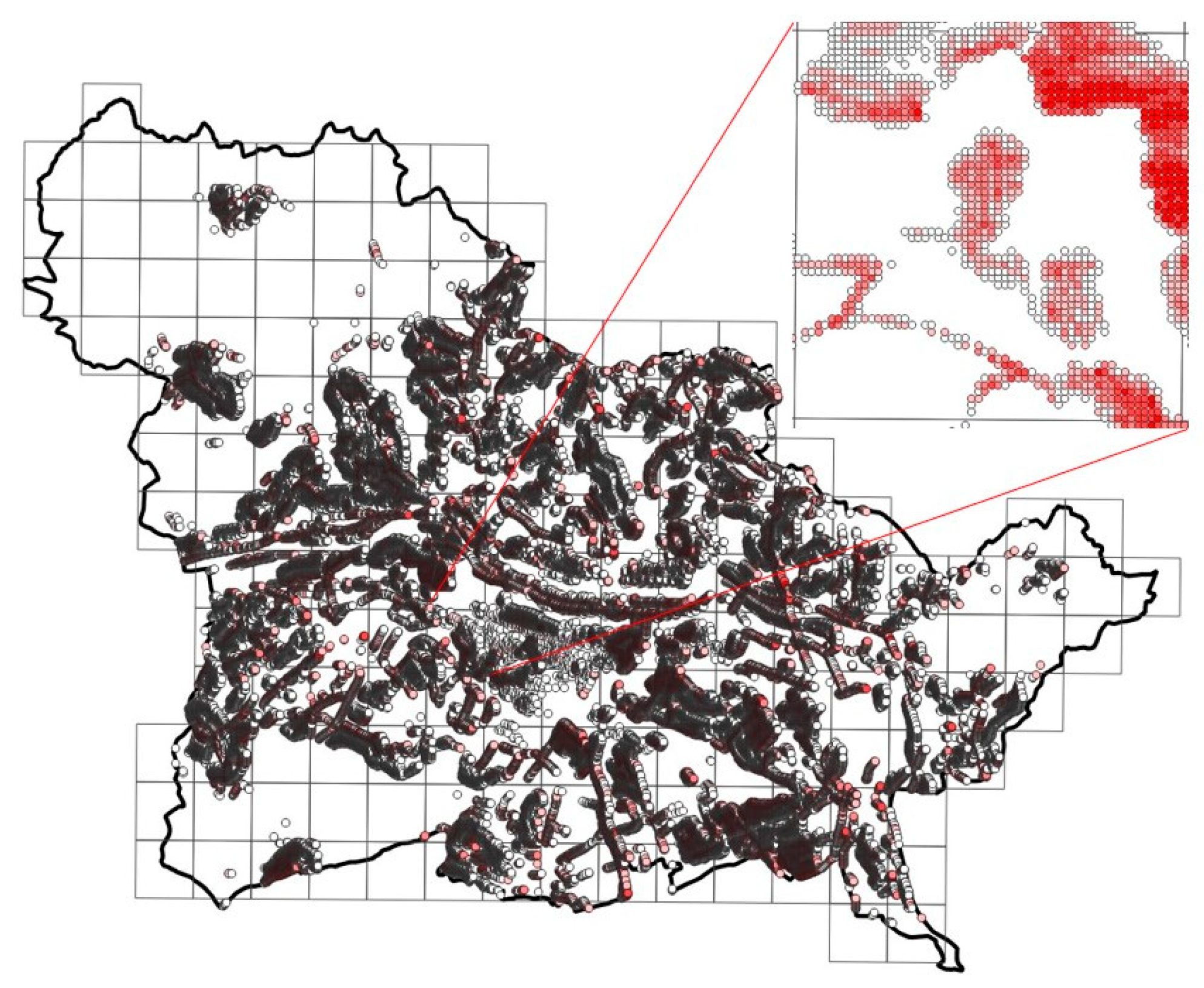
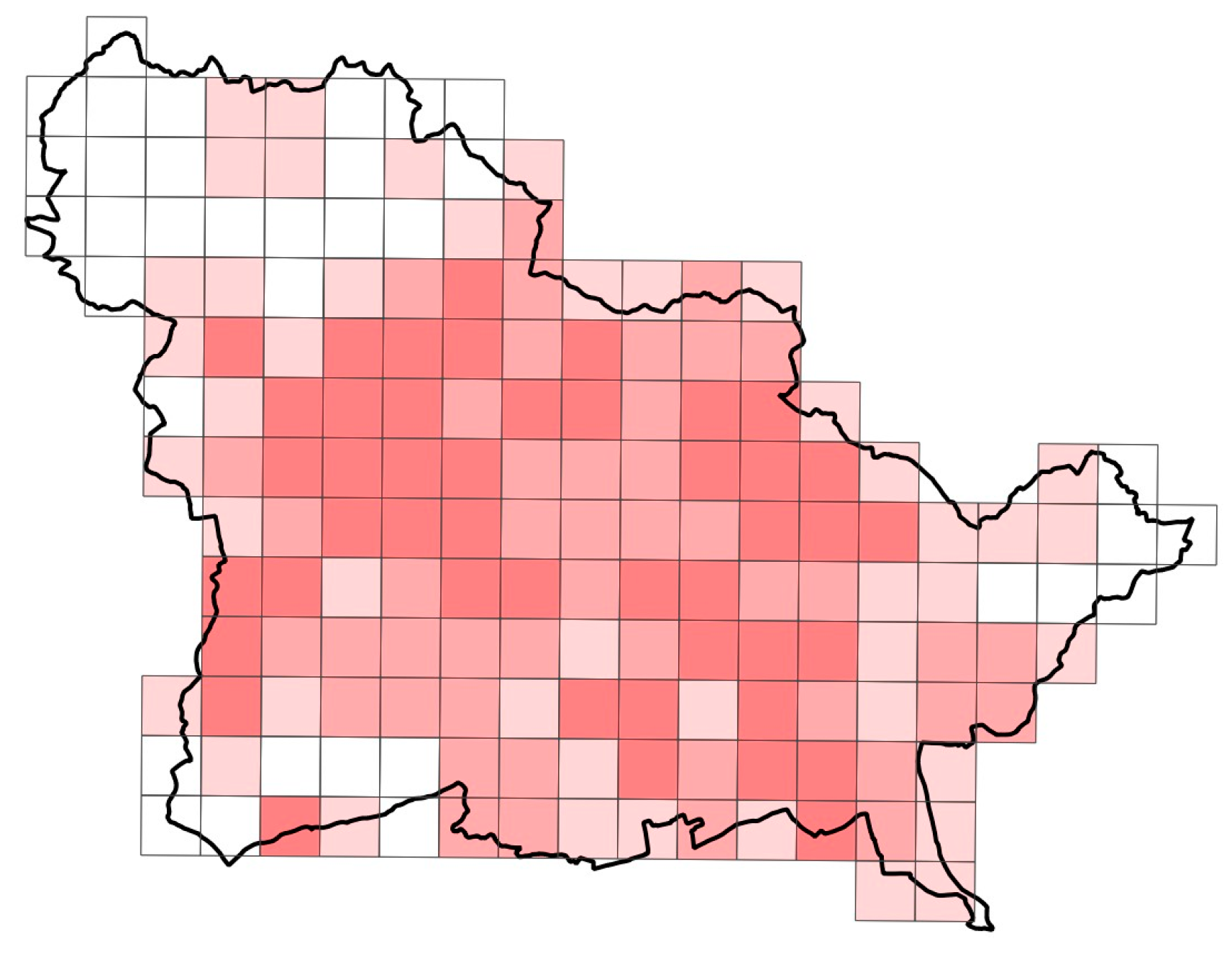
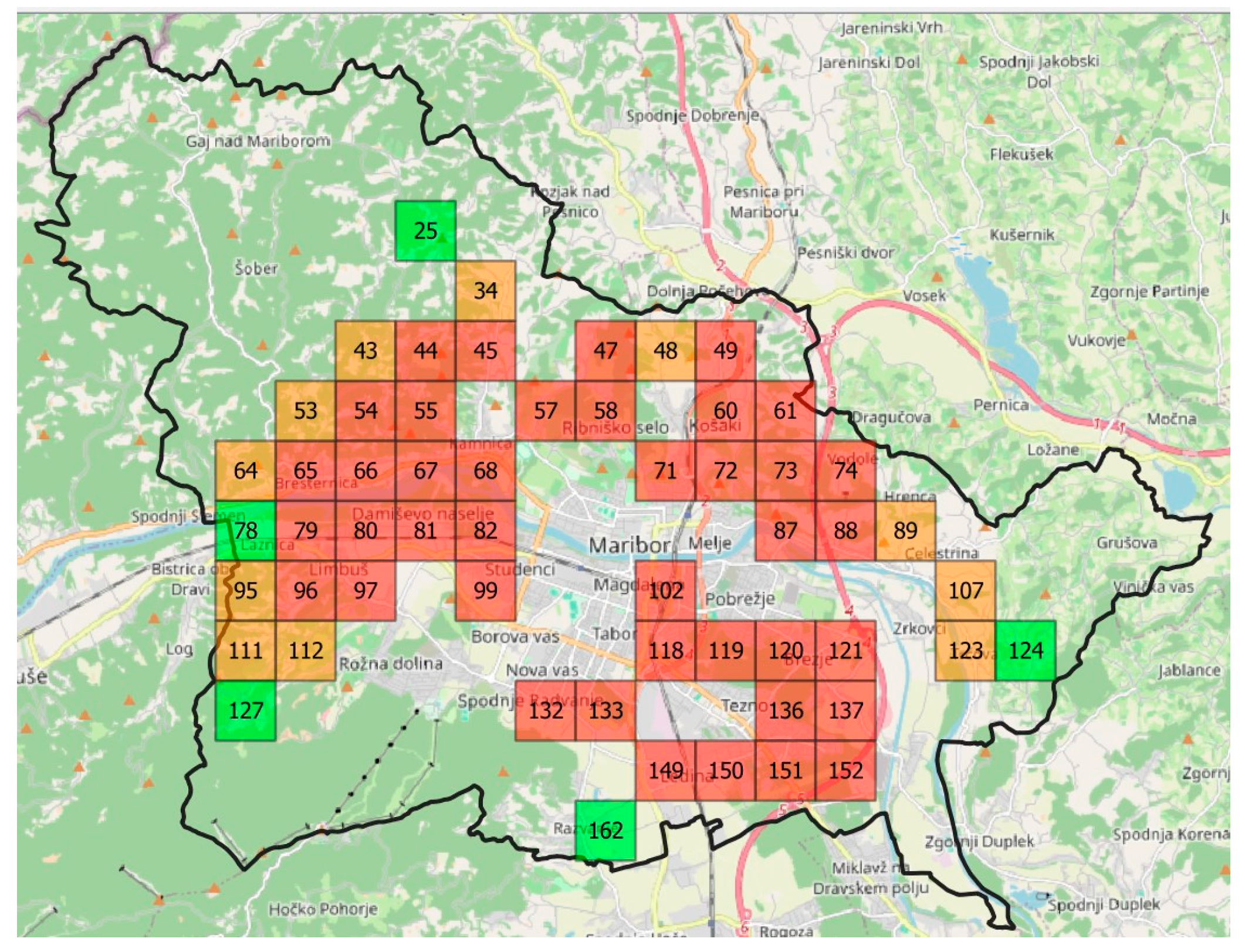
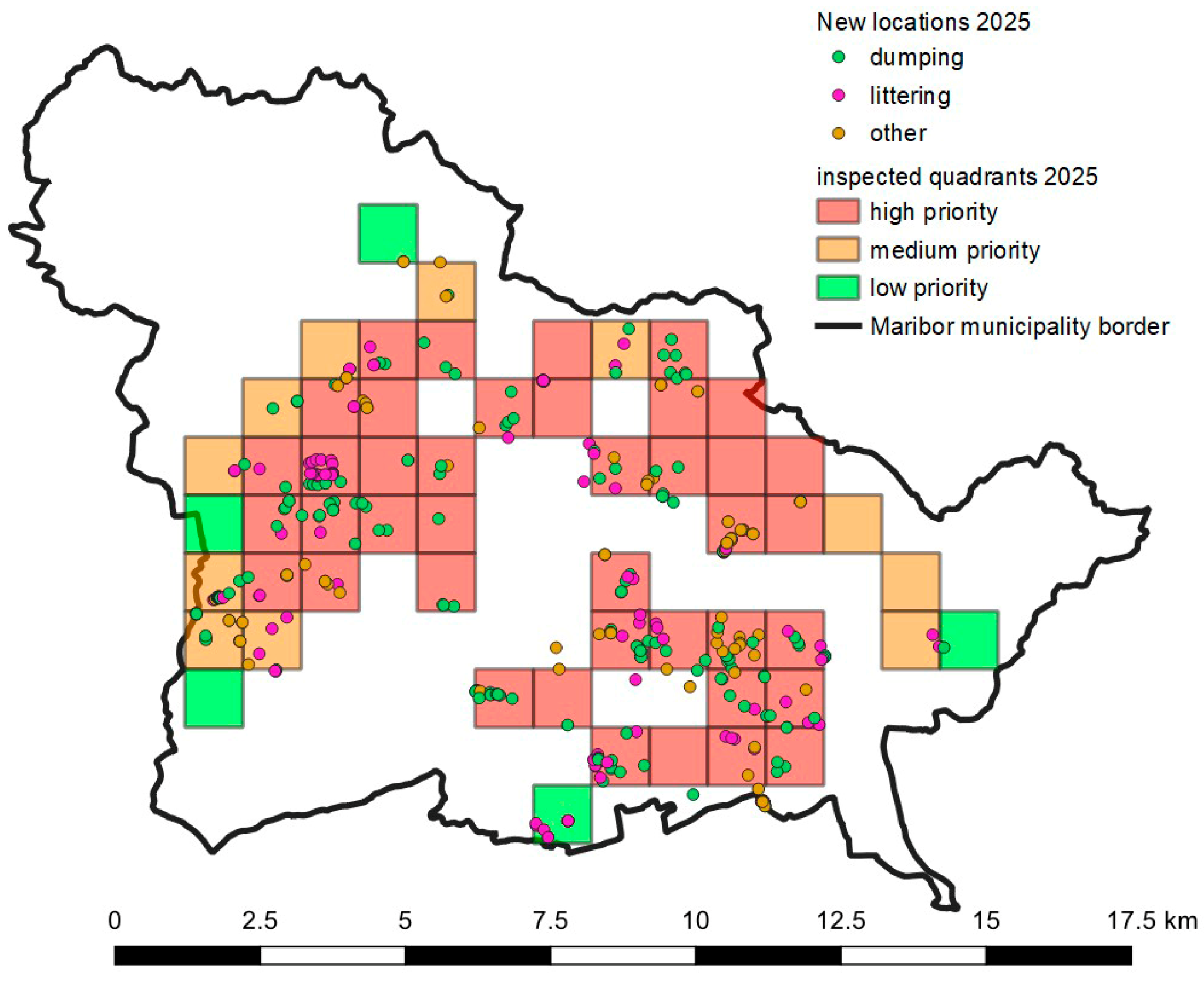
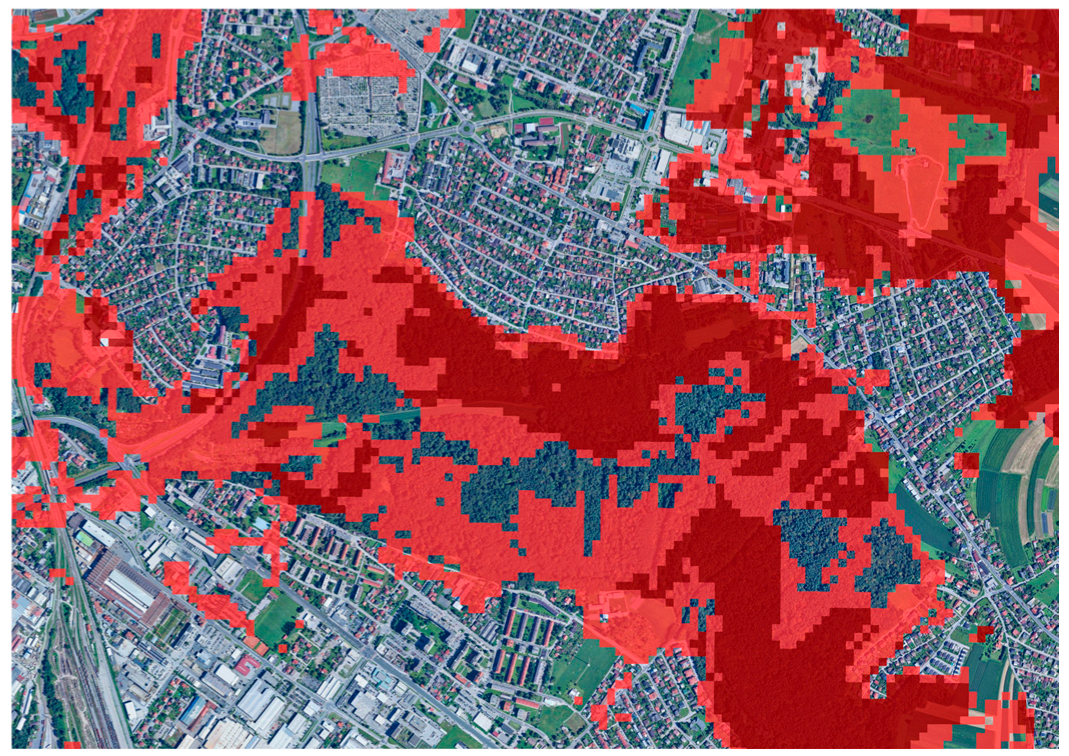
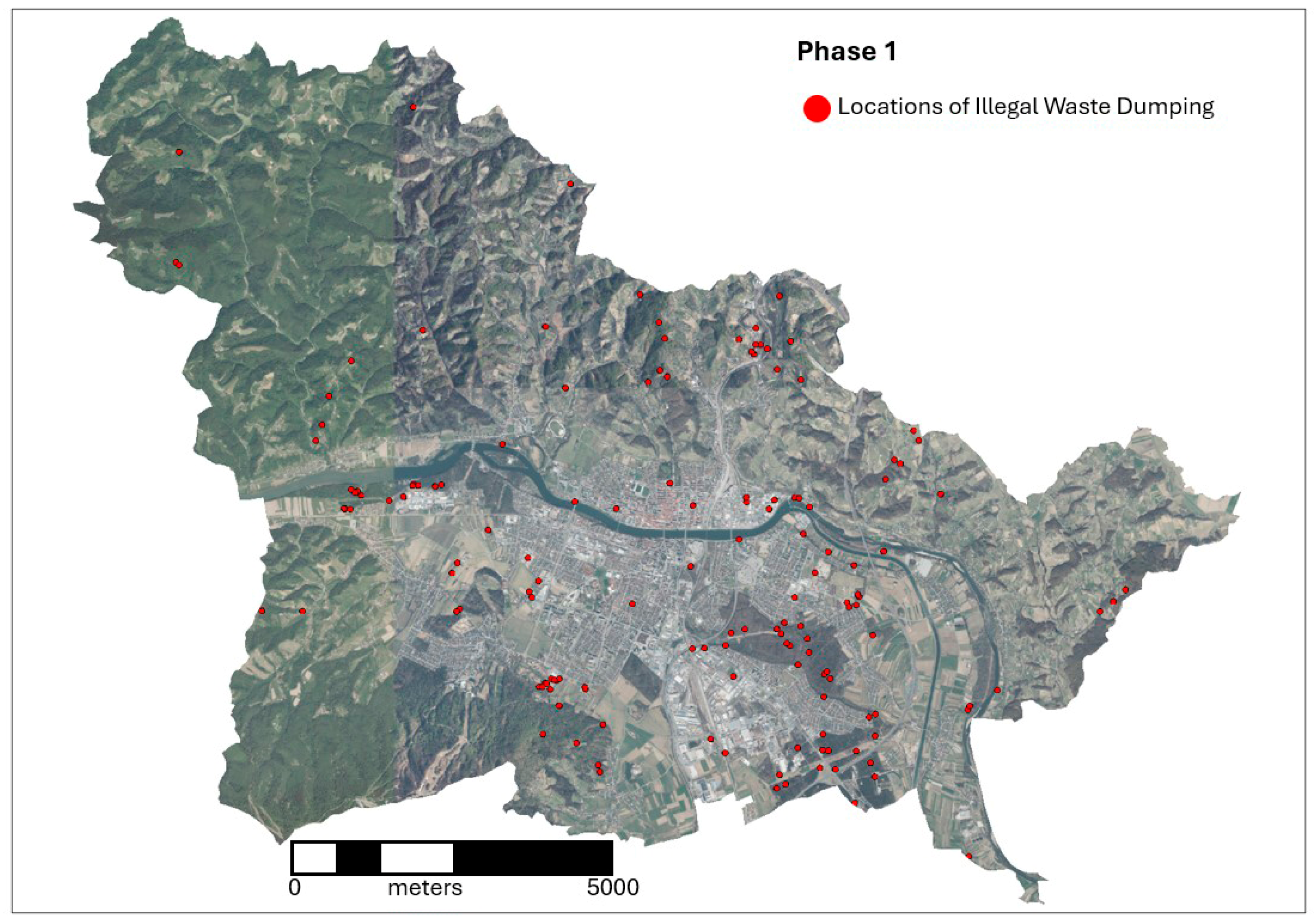
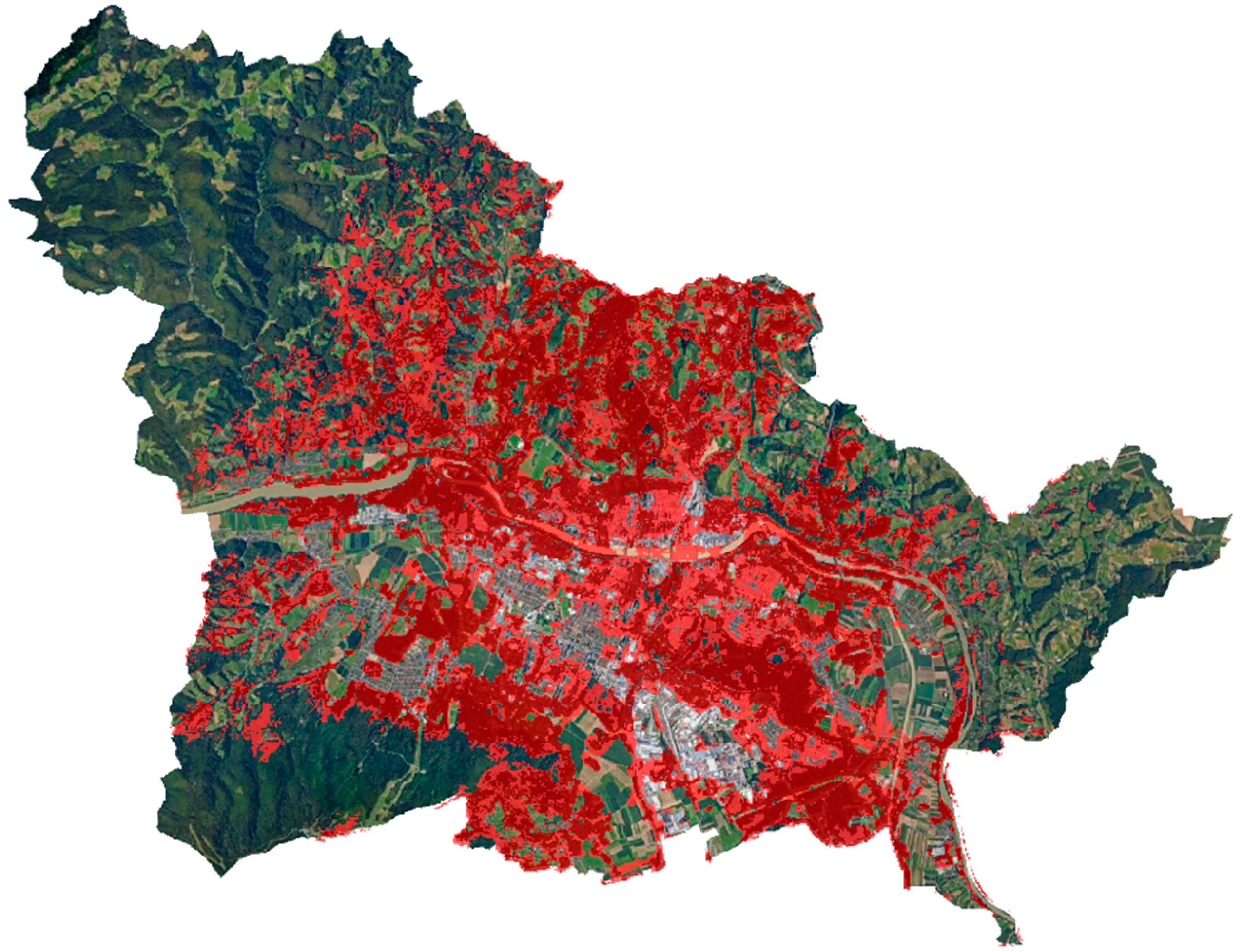

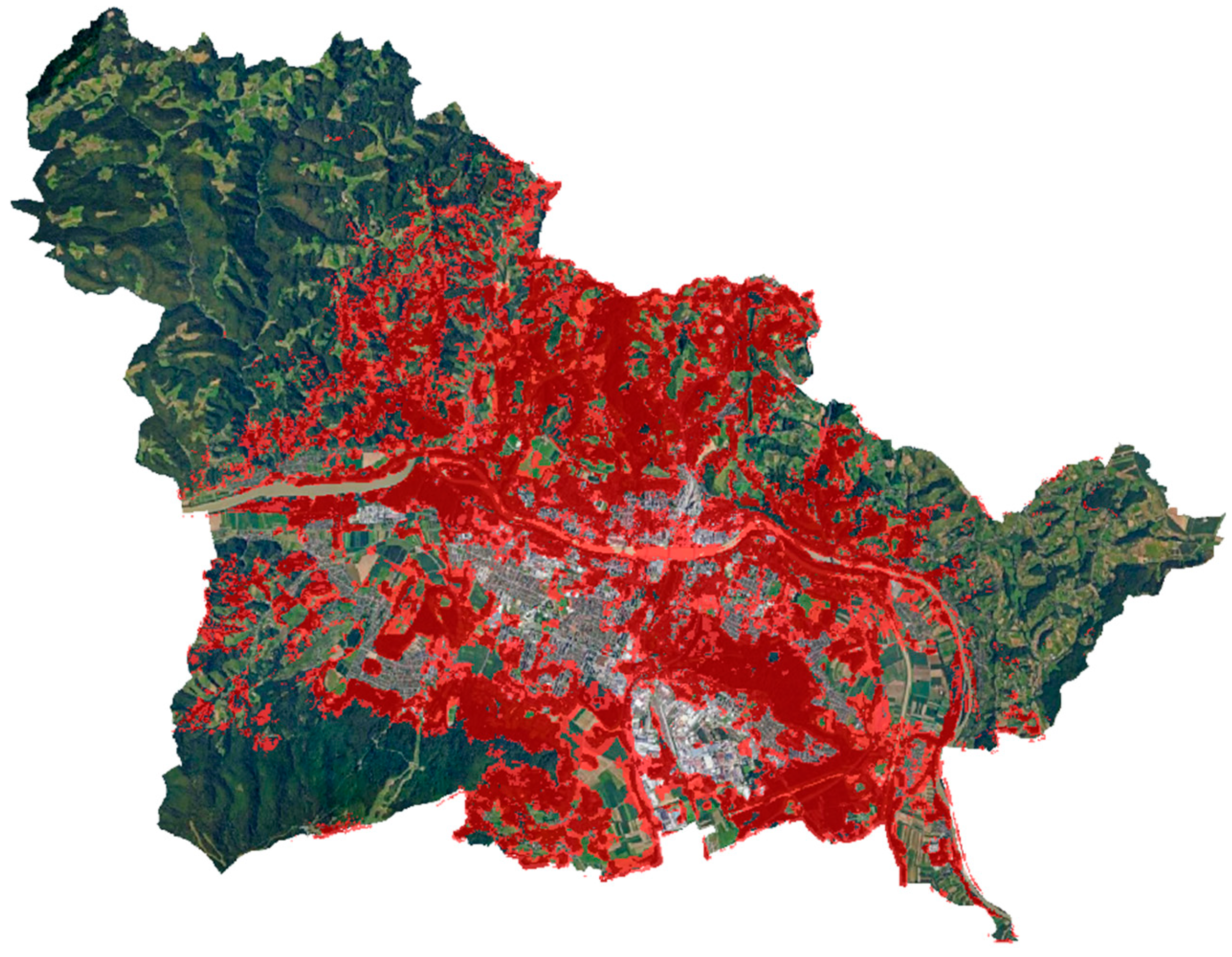
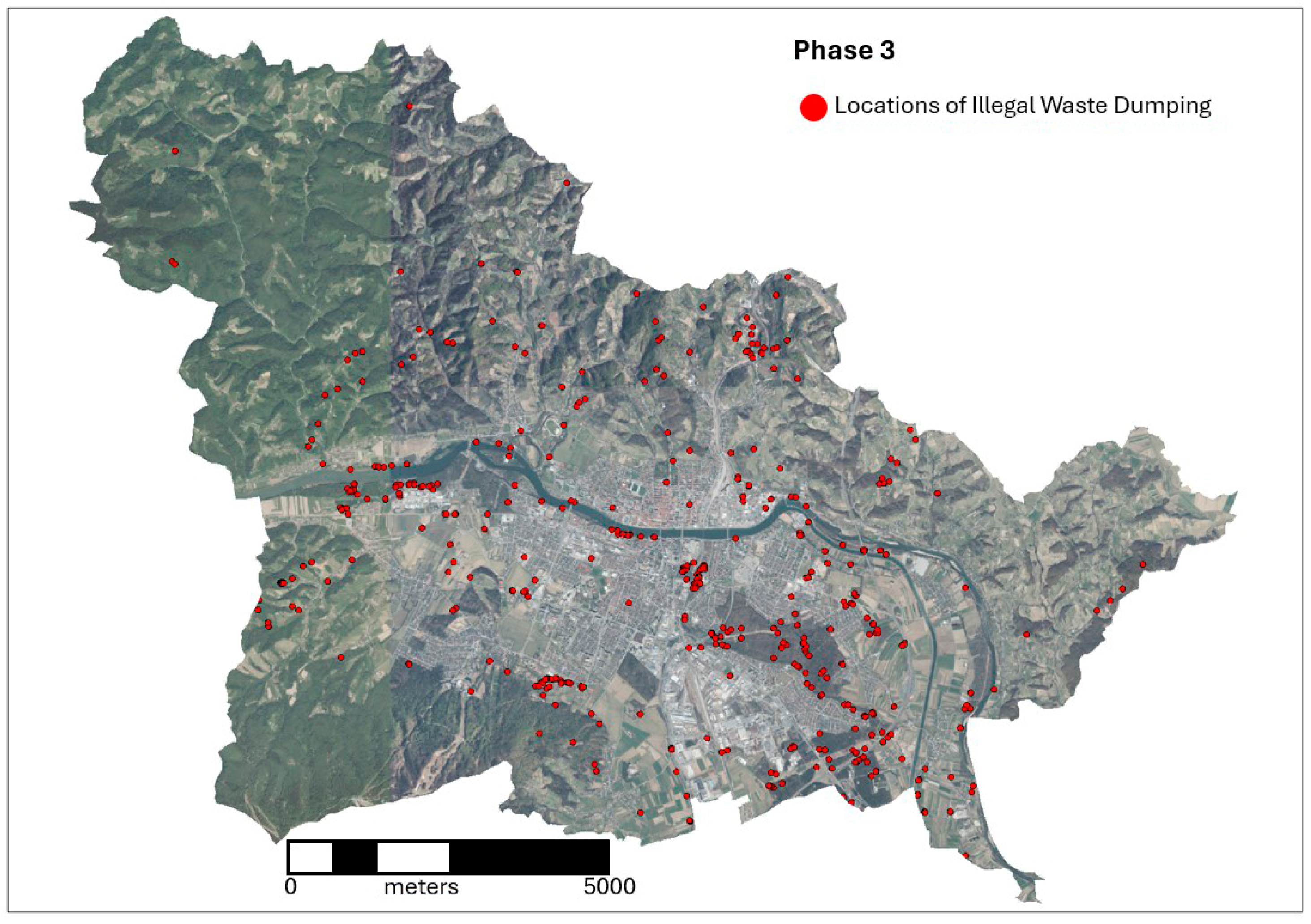
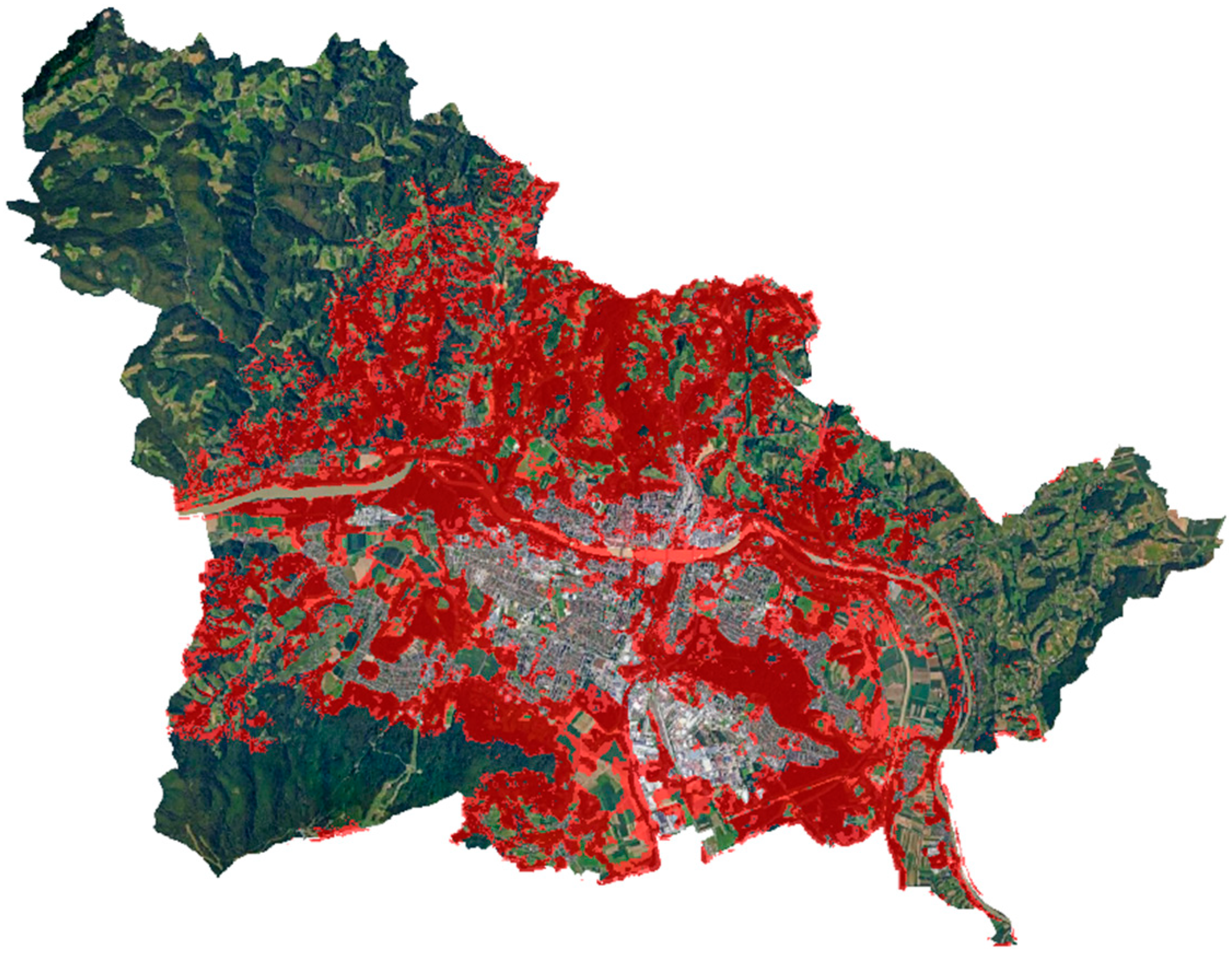

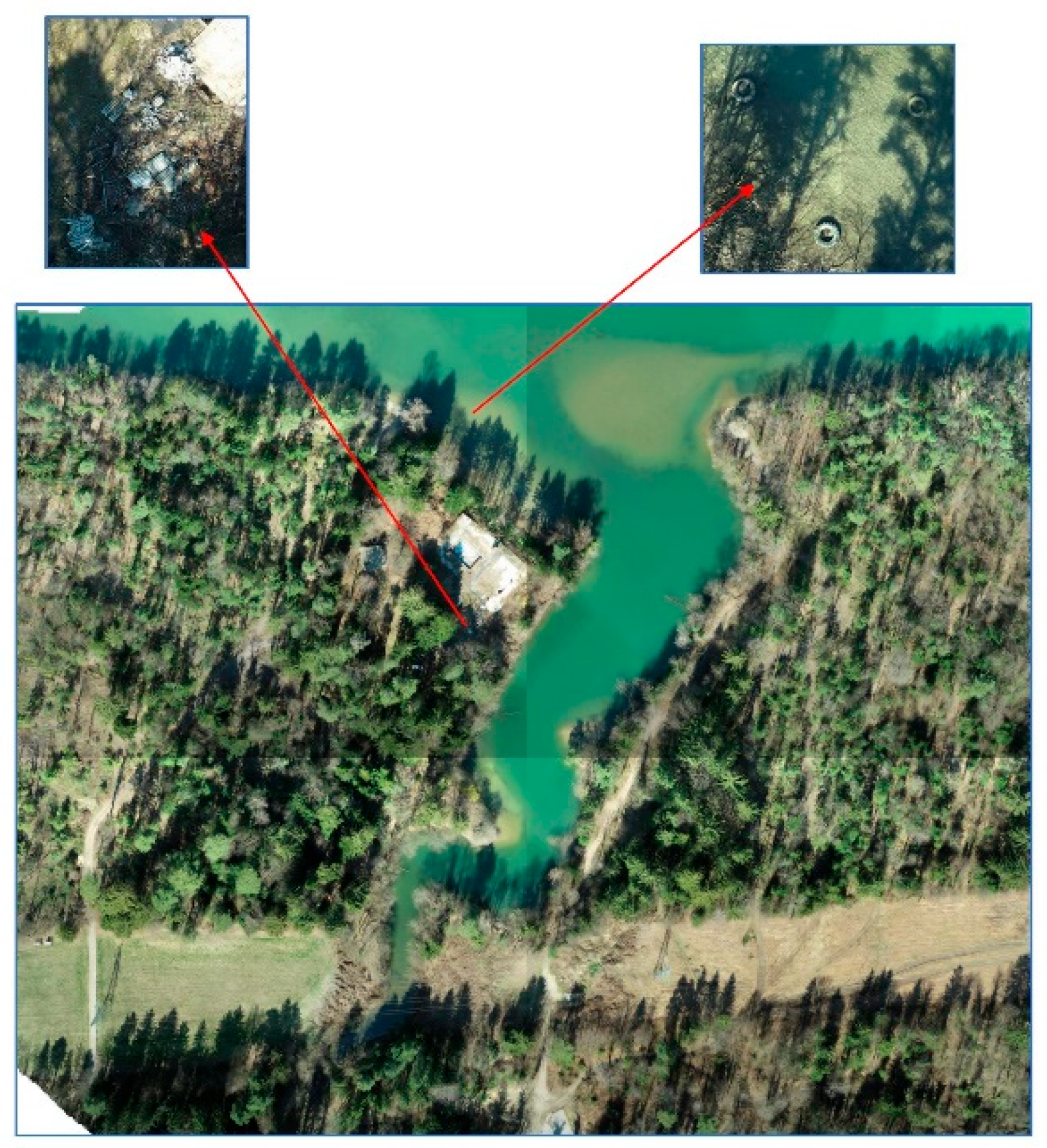
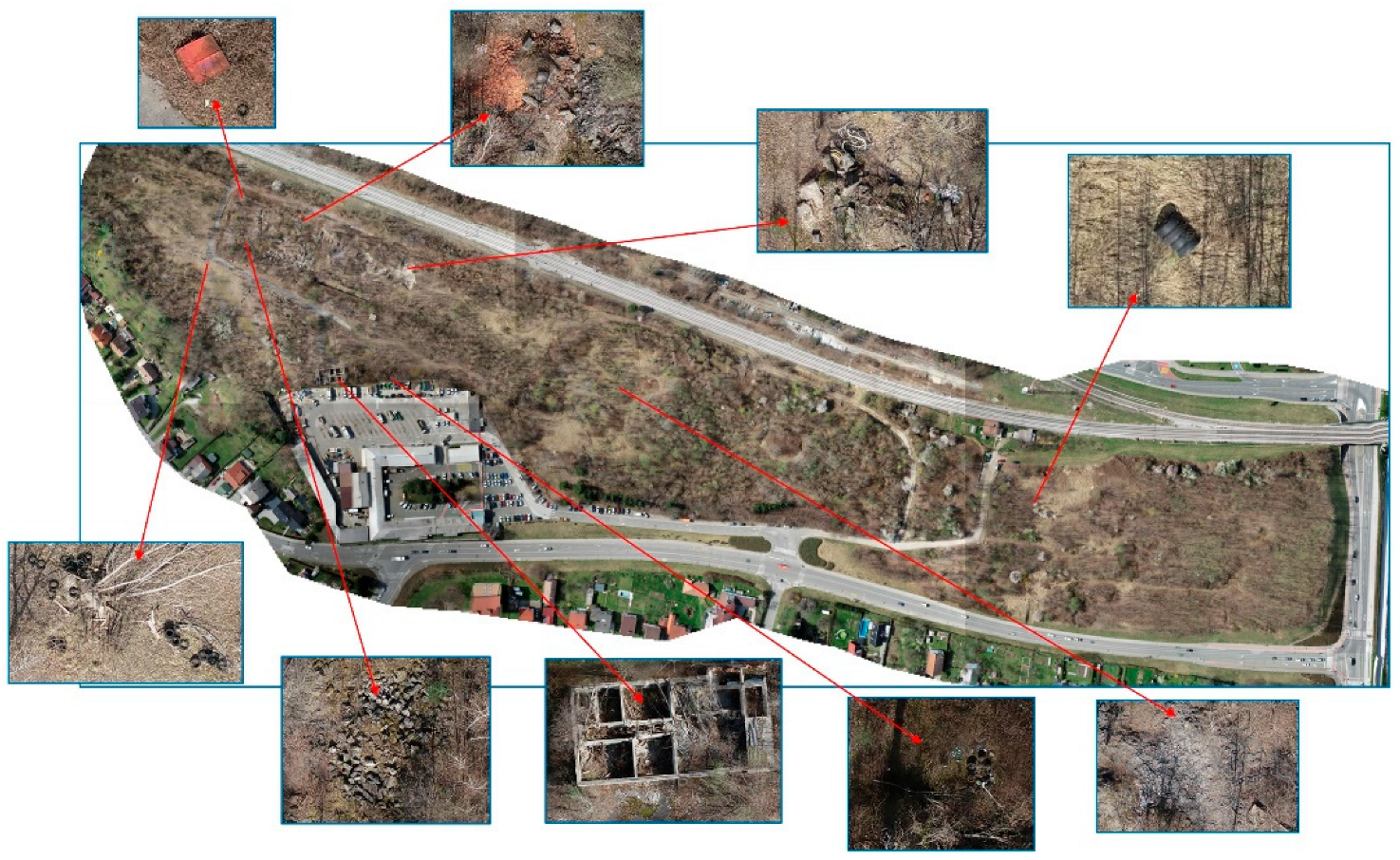
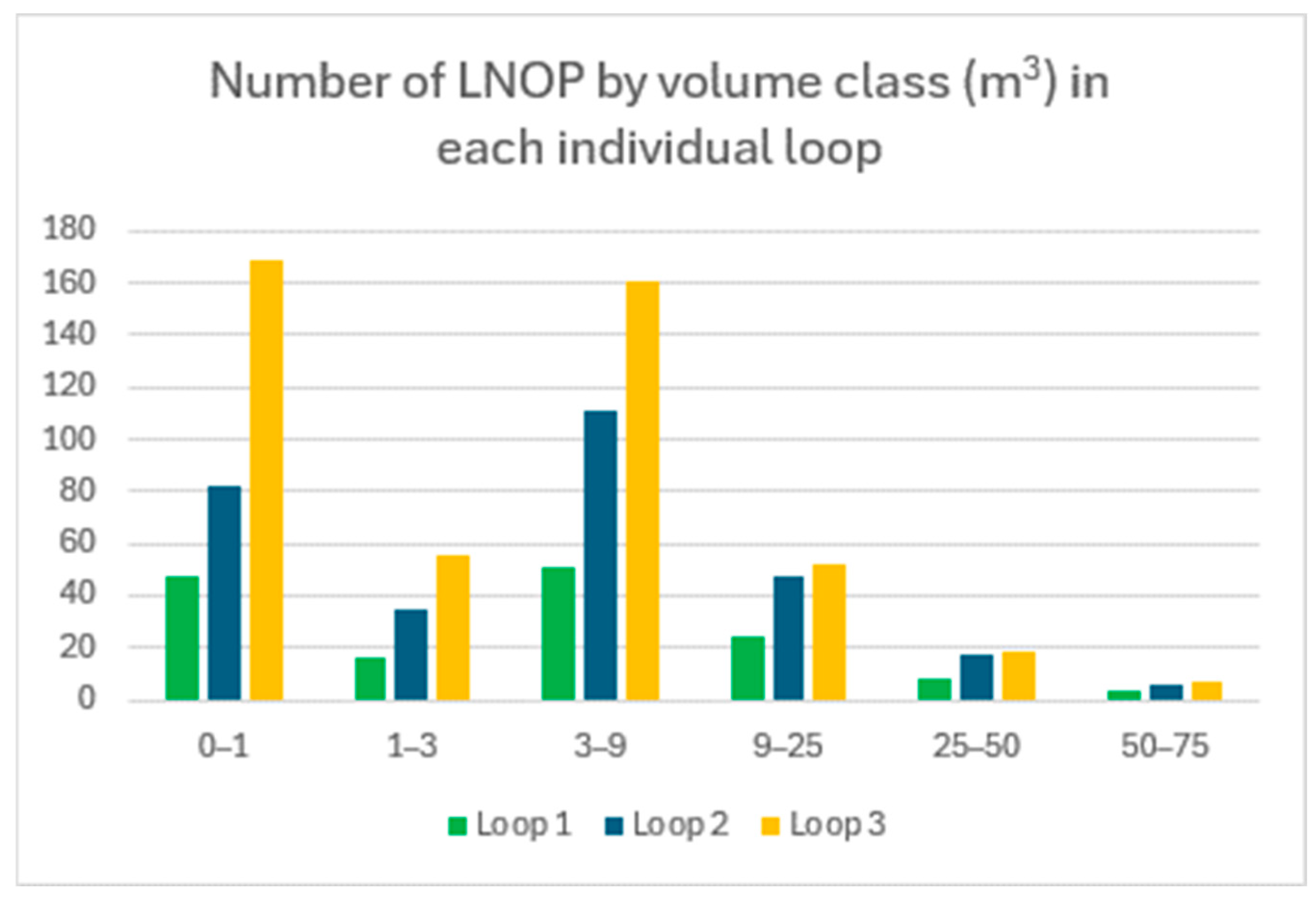
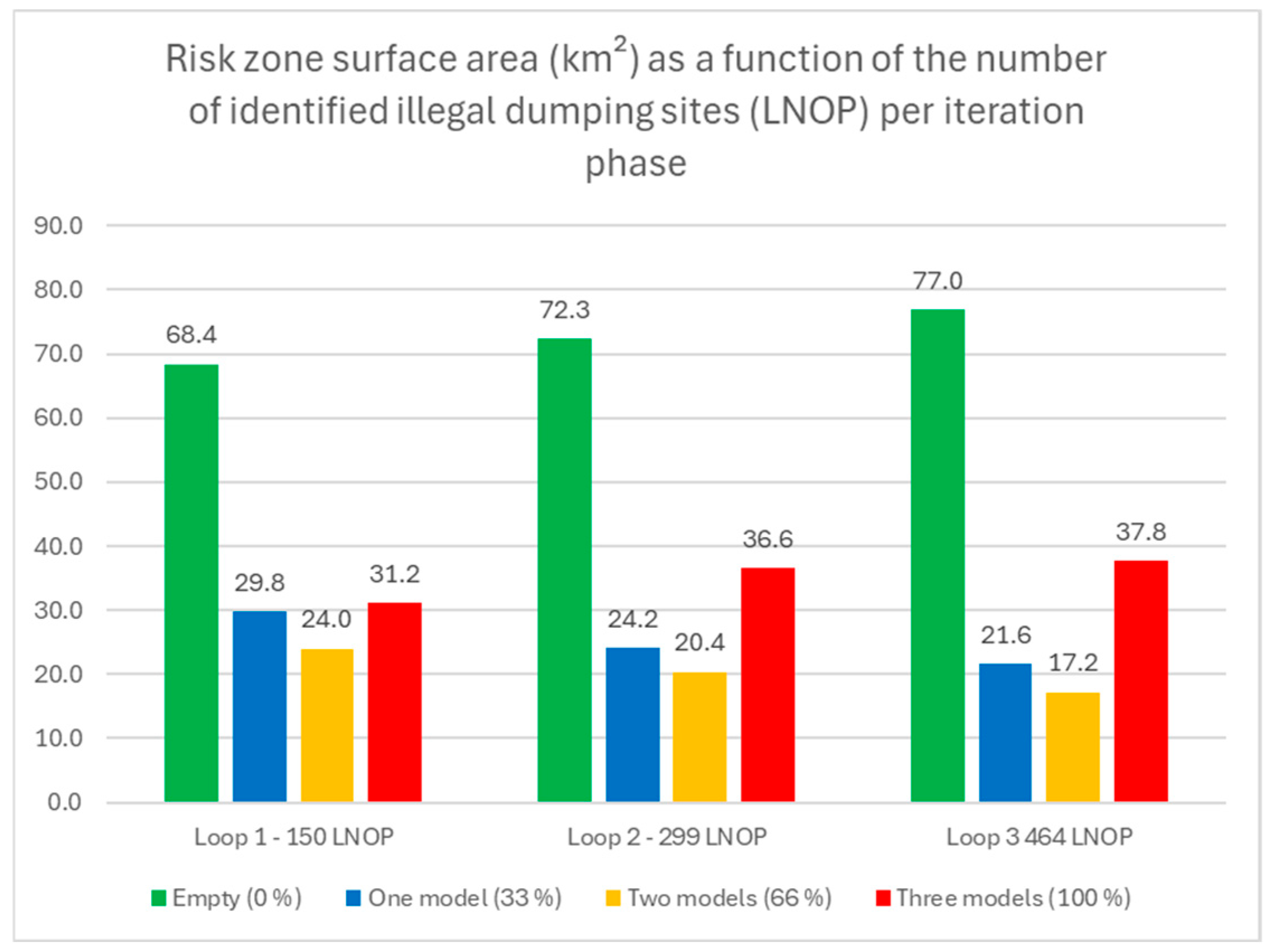
| Loop | Time Frame | Data Source | Number of LNOP | Estimated (Recorded) Waste Quantity (m3) | Recording Method |
|---|---|---|---|---|---|
| 1 | 2010–2018 | EBM | 150 | 1.310 | Volunteers field records |
| 2 | Spring of 2024 | Primary field survey conducted independently, enriched with supplementary information provided by the intermunicipal inspectorate and representatives of the local community | 299 | 2.313 | Validation of prior entries, field inspection, and systematic documentation of existing and newly detected LNOP, with UAV-assisted support |
| 3 | Spring of 2025 | Data obtained through the “Maribor 2025” cleanup campaign and student field exercises | 463 | 2.827 | On-site recording of LNOP using a purpose-built application, with supplementary UAV support |
| Volume Class (m3) | Loop 1 | Difference Between Loop 1 and Loop 2 | Loop 2 | Difference Between Loop 2 and Loop 3 | Loop 3 |
|---|---|---|---|---|---|
| 0–1 | 47 | 35 | 82 | 87 | 169 |
| 1–3 | 16 | 19 | 35 | 20 | 55 |
| 3–9 | 51 | 60 | 111 | 50 | 161 |
| 9–25 | 24 | 24 | 48 | 4 | 52 |
| 25–50 | 8 | 9 | 17 | 2 | 19 |
| 50–75 | 4 | 2 | 6 | 1 | 7 |
| Validation Data | |||
|---|---|---|---|
| Loop 1 | Loop 2 | Loop 3 | |
| Training data—Loop 1 | 64.7 (±4.7) | 59.9 (±4.9) | 63.9 (±5.6) |
| Training data—Loop 2 | 74.0 (±3.5) | 80.9 (±3.3) | 82.7 (±3.9) |
| Training data—Loop 3 | 74.0 (±3.8) | 79.9 (±3.3) | 84.5 (±3.0) |
| Quasi-AUC (%) | |
|---|---|
| Loop 1 | 81.2 (±0.22) |
| Loop 2 | 82.7 (±0.21) |
| Loop 3 | 84.1 (±0.13) |
Disclaimer/Publisher’s Note: The statements, opinions and data contained in all publications are solely those of the individual author(s) and contributor(s) and not of MDPI and/or the editor(s). MDPI and/or the editor(s) disclaim responsibility for any injury to people or property resulting from any ideas, methods, instructions or products referred to in the content. |
© 2025 by the authors. Licensee MDPI, Basel, Switzerland. This article is an open access article distributed under the terms and conditions of the Creative Commons Attribution (CC BY) license (https://creativecommons.org/licenses/by/4.0/).
Share and Cite
Hojnik, B.; Horvat, G.; Mongus, D.; Brumen, M.; Kamnik, R. Towards Sustainable Waste Management: Predictive Modelling of Illegal Dumping Risk Zones Using Circular Data Loops and Remote Sensing. Sustainability 2025, 17, 8280. https://doi.org/10.3390/su17188280
Hojnik B, Horvat G, Mongus D, Brumen M, Kamnik R. Towards Sustainable Waste Management: Predictive Modelling of Illegal Dumping Risk Zones Using Circular Data Loops and Remote Sensing. Sustainability. 2025; 17(18):8280. https://doi.org/10.3390/su17188280
Chicago/Turabian StyleHojnik, Borut, Gregor Horvat, Domen Mongus, Matej Brumen, and Rok Kamnik. 2025. "Towards Sustainable Waste Management: Predictive Modelling of Illegal Dumping Risk Zones Using Circular Data Loops and Remote Sensing" Sustainability 17, no. 18: 8280. https://doi.org/10.3390/su17188280
APA StyleHojnik, B., Horvat, G., Mongus, D., Brumen, M., & Kamnik, R. (2025). Towards Sustainable Waste Management: Predictive Modelling of Illegal Dumping Risk Zones Using Circular Data Loops and Remote Sensing. Sustainability, 17(18), 8280. https://doi.org/10.3390/su17188280







